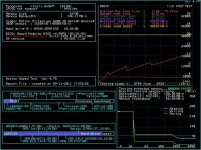Hi, I thought i replied to this thread a few days ago but it didn't show up.
I don't know if your still having trouble with this, but I once read somewhere in the PC guide (i think in the section on RAID), that if you put an Ultra2 drive on a UltraWide bus, the *internal* data transfer rate halves as well. I may have mus-remembered this, or the source. It sounded like faulty reasoning to me at the time. If it is true, (At least on some drives) it could be contributing to your problem. If it wasn't the PC Guide it was another very good source of info, but then there can always be mistakes.
Say you have an Ultra Wide drive, 40MB/s, with an internal transfer rate of 12MB/s If you put it on a fast-wide controller at 20MB/s you'd get 6MB/s, according to the logic above. If you then put it on a fast narrow channel at 10MB/s, it would half the speed again to 3MB/s.
I think its a bit odd to design a drive like this, but it could be designed as such for simplicity. I know of at least one drive that had a jumper to set it to UltraSCSI from Ultra2. Perhaps setting it to UltraSCSI set some divider with respect to the internal transfer rate, as well as putting it into SE mode. "internal transfer rate" is a murky term, as we are dealing with a complex drive, so don't flame me.
Have you also checked termination? I had some IBM Ultra2 drives that don't like anything other that termination fit for ultra2 or better. If you put them on an UltraWide channel they worked poorly, strange lockups in bios scan etc. This could have been due to something else, but they worked fine with an ultra 2 controller and cable with terminator. If you factor in the narrow connection as well, this complicates things further. If you have:
Terminated Controller---------Adapter & 68pin drive--------50pin terminator
Where --- is 50pin cable.
it should work, but as i understand it violates termination rules. The bus is terminated but the drive is only half terminated.
The correct way is:
68pin terminator=======50pin adapter & unterminated Controller======68pin drive===68pin terminator
where === is 68pin cable.
I think the drive also has to provide the termination power.
Check if there are any other jumpers on the drive to set sync speed, sometimes there are some itty bitty ones on the bottom.
One long shot is also checking that the card is set at the correct speed for the VLB. Over or under clocked, the behavior is hard to determine. Performing a "Low level format" on the drive, when the bios cant determine its correct size is not something I would do. If the bios is telling the drive to do an actual low level format i don't think its going to make any difference, and if the bios can somehow do the format itself i think this is going to cause more problems.
There is a contemporary review somewhere in InfoWorld, about about VLB SCSI cards and they were not blown away
with the performance compared to EISA. Bios updates may have fixed this.




